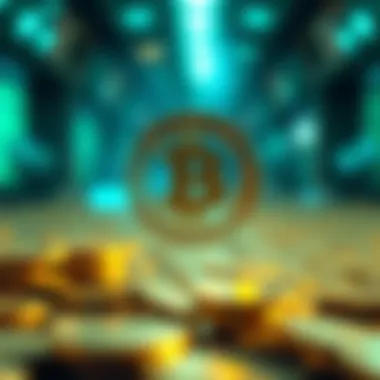Comprehensive Guide to Understanding Non-Fungible Tokens


Market Trends
The advent of non-fungible tokens (NFTs) has ushered in a new era in the world of digital assets, capturing the attention of traders, investors, and analysts alike. In a landscape where the blend of technology and creativity flourishes, the rise of these unique digital tokens is part of a larger economic narrative. Understanding market trends surrounding NFTs requires an in-depth look into both current configurations and historical patterns that have shaped the present landscape.
Current Market Analysis
As of the latest reports, the NFT market has demonstrated resilience in the face of broader economic fluctuations. High-profile sales continue to make headlines, with pieces like digital artwork fetching millions at auctions. Analysts suggest that this trend underscores the growing acceptance of NFTs not just as collectibles but as potential investment vehicles.
- Sales Volume Growth: Recent data shows that the market has seen a year-on-year increase in transaction volume, suggesting not just a trend but a developing economic model built around these tokens.
- Diverse Applications: From art to real estate, NFTs are diversifying their application scope, highlighting the adaptability of this technology.
This current economic scenario is fueled by increasing participation from various sectors, including entertainment, gaming, and even educational institutions, all exploring ways to integrate NFTs into their frameworks.
Historical Trends and Patterns
To truly grasp where NFTs stand today, one must consider their historical trajectory. This journey began with the creation of tokens like Cryptokitties which showcased the concept of rarity in the digital world. Over time, we witnessed a gradual shift toward more complex utilities coupled with large-scale adoption.
- Early Adopters and Evolution: Early NFT projects spurred curiosity but often catered to niche audiences.
- Mainstream Visibility: With celebrities and prominent brands entering the space, a significant uptick in visibility occurred, driving up interest and investment from mainstream audiences.
- Economic Cycles: The NFT market has also been subject to boom and bust cycles similar to traditional markets, but the unique nature of NFTs adds layers of complexity in understanding these patterns.
“The NFT phenomenon isn’t simply a passing fancy; it represents a transformation in how ownership and value are perceived in the digital realm.”
Investment Strategies
When considering investing in NFTs, it is essential to develop a strategic approach tailored to the unique characteristics of this market. Knowing the difference between long-term and short-term investments can significantly influence financial outcomes.
Long-Term vs Short-Term Investments
- Long-Term Investments: These are typically associated with the belief in the sustained value and evolution of the NFT space. Early investors in landmark projects, like CryptoPunks, have seen substantial returns as the cultural significance of their holdings increased.
- Short-Term Investments: The flipper mentality drives this strategy, where investors capitalize on immediate trends and speculative hype. Anticipating which digital assets will surge in popularity can lead to quick profits, but it also carries elevated risks.
Risk Management Techniques
Navigating the NFT market is not without its hazards. A sound risk management strategy can mitigate potential losses and optimize gains.
- Diversification: Just as one wouldn't put all their eggs in one basket in traditional investing, the same applies here. Consider spreading investments across various NFT categories.
- Due Diligence: Research the background, technology, and community behind any NFT project before committing funds.
- Market Timing: Keep an eye on market sentiment and timing can be crucial. Engaging in transactions during peaks might yield high returns but can also lead to significant losses.
Foreword to Non-Fungible Tokens
The landscape of digital assets has changed significantly over recent years, primarily due to the rise of non-fungible tokens, commonly known as NFTs. To grasp the essence of NFTs, it's essential to look beyond mere definitions. Non-fungible means that these tokens are unique and cannot be exchanged on a one-to-one basis, unlike traditional cryptocurrencies such as Bitcoin or Ethereum. This article aims to shed light on the critical elements surrounding NFTs, offering insights into their significance in today's digital economy.
Understanding NFTs is vital as they represent more than just a passing trend; they signify a paradigm shift in how ownership, value, and creativity merge within the digital sphere. The benefits of NFTs include proof of ownership, provenance tracking, and enabling new forms of monetization for creative works. They open avenues for artists, gamers, and collectors, shifting the dynamics of art, music, gaming, and even real estate into more equitable and accessible models.
However, with this rapid evolution comes a host of considerations. There are debates around the implications of ownership rights and economic factors at play, particularly regarding the fluctuations in value driven by market demand. The conversations surrounding these aspects are as relevant to seasoned traders and investors as they are to artists seeking new platforms for their works.
In a nutshell, the introduction of non-fungible tokens presents both opportunities and challenges, carving a unique niche within the wider cryptocurrency landscape. As we navigate through this article, we will delve deeper into the definition and historical context of NFTs, unraveling their intricate characteristics and exploring their impact across different industries, ensuring a comprehensive understanding of this pivotal topic.
Definition of Non-Fungible Tokens
Before we can truly appreciate the scope of non-fungible tokens, it’s crucial to define what exactly they are. NFTs are digital assets that represent ownership or proof of authenticity of a unique item or piece of content, be it art, music, virtual real estate, or even tweets. Unlike everyday currencies or cryptocurrencies, which are interchangeable, NFTs are distinct. Just as no two vintage baseball cards are alike, each NFT is different and holds its own value based on factors like rarity, creator, and demand in the marketplace.
This inherent uniqueness is a key feature of NFTs, allowing for verification of ownership and the ability to buy and sell these assets in a secure manner. NFTs are typically created using blockchain technology, which ensures that each token is securely connected to an immutable digital ledger. This technological foundation enhances transparency and trust, critical components in an era where digital fraud is rampant.
Historical Context of NFTs
The journey of non-fungible tokens is as fascinating as the concept itself. Understanding their development requires a glance into the evolution of blockchain technology and digital assets. The idea of unique digital items can be traced back to early digital collectibles in the late 2010s, but it was the launch of Cryptokitties in 2017 that put NFTs on the map. This blockchain-based game allowed users to breed, trade, and sell virtual cats, with some selling for staggering sums.
As digital art began gaining traction through platforms like SuperRare and Foundation, the NFT market witnessed an explosive growth. By 2021, the art world was buzzing with records being shattered in auction houses like Christie's, where digital pieces fetched millions of dollars. This shift not only legitimized NFTs in the art sector but also sparked interests in gaming, music, and even virtual real estate.
Reflecting on these historical milestones helps to comprehend why NFTs are not merely a fad but a phenomenon reshaping industries before our eyes. This historical context will serve as a backdrop as we further explore the complexities of NFT functionality and its implications in our evolving digital landscape.
The Anatomy of NFTs
The section on the anatomy of non-fungible tokens (NFTs) serves to unpack the layers that contribute to their uniqueness and functionality. Understanding these components is vital for grasping how NFTs operate and why they are reshaping the dynamics of digital ownership and commerce. Each facet, from their non-fungible nature to the technical underpinnings of blockchain technology, plays a crucial role in defining their value and application across various sectors.
Unique Features of Non-Fungibility


Non-fungibility is the cornerstone that distinguishes NFTs from cryptocurrencies like Bitcoin or Ethereum. While Bitcoin can be exchanged for another Bitcoin without loss of value, NFTs are inherently unique. This uniqueness is pivotal in various industries, especially art, gaming, and virtual real estate. One can draw parallels to collectibles—think of rare baseball cards or vintage stamps, where each item has its significance and worth beyond mere materials.
- Authenticity: NFTs provide verifiable proof of authenticity. In the digital realm, where duplication is easy, having a blockchain-backed certificate of authenticity makes all the difference.
- Ownership: The ability to own a digital asset outright transforms the game. Users can buy, sell, or trade their NFTs without reliance on third parties, maintaining control of their investments from start to finish.
- Creativity and Monetization: Artists and creators can embed royalties directly into the NFT’s smart contract, ensuring they earn a percentage every time their work is resold. This ability championed the rights of creators in ways traditional art markets often overlook.
Technical Framework: Blockchain Technology
The technical framework supporting NFTs primarily hinges on blockchain technology. This decentralized ledger creates an immutable record of transactions, enhancing security and transparency.
Blockchain Basics
At the core of blockchain technology is its decentralized nature. Unlike traditional databases controlled by a single entity, blockchains operate on a network of computers. This dispersion means that data is validated by multiple parties, reducing the risk of fraud or corruption. Blockchain's inherent qualities, such as transparency and security, make it a favored choice for NFTs.
- Advantages: Consensus mechanisms in blockchain ensure that every transaction is accurate and secure, fostering trust among users. Moreover, the permanence of records aids in creating a historical timeline of ownership for each NFT.
- Disadvantages: On the flip side, scalability issues can plague some blockchains, leading to slower transaction speeds, particularly during high traffic. This problem can frustrate buyers and sellers alike during peak moments.
Smart Contracts
Smart contracts are self-executing contracts with the terms directly written into code. They automate processes, eliminating the need for intermediaries. Their role is critical in the operation of NFTs.
- Key characteristic: The automation of transactions through smart contracts is revolutionary. When an NFT is sold, the smart contract facilitates the transfer of ownership while ensuring that the original artist receives royalties.
- Benefits: This feature removes human error and trust issues, as everything is predetermined and executed as per the programmed parameters. It can lead to a more efficient market.
- Risks: However, bugs in the code can lead to exploitation. Poorly written contracts may become exploits, risking the assets they were intended to protect.
Token Standards: ERC-721 vs ERC-1155
Token standards define how NFTs are structured on the blockchain, with ERC-721 and ERC-1155 being among the most common. Understanding the difference can clarify their applications.
- ERC-721: This standard allows for the creation of unique tokens, perfect for art or individual items. Each token has distinct attributes and value, which aligns well with the non-fungible nature of NFTs.
- ERC-1155: This brings a twist by allowing a single contract to manage multiple token types. This flexibility is advantageous for gaming applications, where both unique assets and fungible tokens (like currency) coexist.
The choice between these standards often hinges on specific project requirements—an artist may prefer ERC-721 for exclusivity, whereas a game developer might opt for ERC-1155 for efficiency.
In summary, the anatomy of NFTs is built upon a unique blend of non-fungible qualities and sophisticated technology. By understanding this framework, traders, investors, and tech enthusiasts can better appreciate the transformative power NFTs hold in today's digital landscape. The emergence of these tokens is not merely a trend but points to a fundamental shift in how we perceive and commodify digital assets.
Applications of Non-Fungible Tokens
The applications of non-fungible tokens (NFTs) have surged into the spotlight, showcasing their groundbreaking potential across various sectors. NFTs carve out unique spaces in our digital landscape, acting as a bridge between ownership, creativity, and commerce. The significance of exploring these applications cannot be overstated as they transform how individuals engage with digital content, assets, and even property. The combinations of creativity, economic dynamics, and technology all intertwine to present a future rich with possibilities and challenges.
NFTs in Art and Collectibles
Digital Art Market Dynamics
The digital art realm is buzzing, largely influenced by the surge of NFT technology. One of the defining aspects of the digital art market dynamics is the ability for artists to sell their work directly to collectors without the need for intermediaries. This streamlined process is not just beneficial for artists seeking autonomy over their creations, but it also invites a diverse range of participants into the market.
Advantages of this dynamic include artists retaining more profits and buyers having a direct interaction with the creators. However, its challenges lie in reinforcing value perceptions amid a flood of available content. With tools like platforms such as OpenSea or Rarible, creators can mint their works into NFTs, yet they must compete with countless others within this digital bazaar.
"In a world where digital content is abundant, standing out in the NFT art space requires more than just talent; it necessitates savvy marketing and a unique voice."
Impact on Traditional Art Sales
The ascent of NFTs has also rocked the boat for traditional art sales. Traditional galleries and auction houses face modern competition as digital marketplaces bring forth new methodologies of buying and selling. As prominent auction houses like Christie’s and Sotheby’s adapt by offering NFT art, the lines between conventional and digital art continue to blur.
A key characteristic of this impact is the increased accessibility it offers to both artists and collectors. More individuals can participate in the art market now than ever before. However, this movement also carries certain drawbacks — the ecosystem's volatility can undermine established artists' reputations and lead to price inflation that is often unsustainable. The cultural and economic implications of this ongoing transformation are significant as they reshape how art is perceived in our society.
Gaming Applications and Virtual Economies
Play-to-Earn Models
In the gaming industry, the incorporation of NFTs has paved the way for innovative play-to-earn models. Players can earn real-world rewards while engaging in gameplay through NFT assets. A standout characteristic of these models is the blend of entertainment with tangible financial benefits. Players are not just passive participants anymore; they hold stakes in the ecosystems they help create.
The allure of earning while playing establishes a more engaging and financially rewarding experience. Yet, compression or inflation of asset values remains a possible disadvantage; an oversupply of NFTs can lead to market saturation. This results in uncertain earning potential, especially for newcomers who risk facing steep learning curves in this ever-evolving landscape.
Game Asset Ownership
Ownership of in-game assets is another pivotal discussion surrounding NFTs in gaming. Players can have true ownership of their digital assets, meaning they can transfer, sell, or even use them across different games. This blurred boundary between virtual and real-world assets offers a unique form of empowerment for players.
However, the concept of ownership now comes with added complexities. Determining what players genuinely own versus what is licensed creates a thin ice for developers and consumers alike. As players navigate through various platforms like Axie Infinity or Decentraland, understanding the nuances of digital ownership is vital for making informed decisions.


NFTs in Real Estate and Property Rights
Fractional Ownership
NFTs introduce fractional ownership in the real estate sector, dividing properties into smaller shares that can be traded or sold easily. This model democratizes access to real estate investments, allowing individuals to own a part of a property instead of dealing with the often prohibitive costs of full ownership. A significant advantage of this approach is the enhanced liquidity in the real estate market that allows for smoother transactions and diversified portfolios.
Nevertheless, legal complexities arise with fractional ownership, including compliance with local property laws and regulations. Navigating these waters requires careful consideration and legal safeguards to ensure that rights are adequately protected.
Transparent Transactions
The introduction of NFTs in real estate also ushers in an era of transparent transactions. Blockchain technology ensures that all transactions are verifiable and tamper-proof, which enhances the trustworthiness of real estate dealings. This major characteristic of transparency allows both buyers and sellers to cut through the clutter often associated with real estate transactions.
While this transparency generates confidence among consumers, it can also expose certain vulnerabilities. Issues such as data privacy and the permanence of blockchain-related information must be addressed to maintain a balance between openness and security in property rights.
In summary, the versatility of NFTs in various sectors exemplifies their growing influence across different markets. Whether reshaping the art scene, altering the gaming landscape, or redefining real estate, NFTs are driving conversations about ownership, value, and the future of digital assets.
Market Dynamics of NFTs
The market dynamics of non-fungible tokens (NFTs) play a crucial role in shaping the landscape of digital assets. Understanding these dynamics is imperative for traders, investors, analysts, and tech enthusiasts who wish to navigate this evolving market. One key aspect involves how NFTs are valued and the mechanisms that underpin their pricing.
In traditional markets, value tends to be tied closely to tangible assets. However, NFTs challenge this notion entirely. These digital tokens represent ownership of unique items, leading to valuation challenges that can seem perplexing at first glance. Factors influencing prices include rarity, demand, and the overall market sentiment, however assessing these aspects can feel like trying to catch smoke with your bare hands. The lack of a standardized valuation framework can lead to dramatic price swings, making investing in NFTs feel like a rollercoaster ride.
Valuation Challenges and Pricing Mechanisms
Valuation of NFTs is not straightforward and often results in heated debates among investors. Unlike cryptocurrencies, which can be valued based on market cap and liquidity, NFTs lack a unified metric for price determination. This necessitates a subjective approach where individual buyers and sellers assess worth based on personal valuation systems.
Key challenges include:
- Market Sentiment: Fluctuations in buyer interest can cause prices to swing wildly. A trending meme or a celebrity endorsement can lead to spikes, while negative publicity can wipe out value overnight.
- Uniqueness vs. Demand: A highly unique NFT may not always command high prices if demand is low, illustrating the delicate balance between rarity and desire.
- Market Saturation: As the number of platforms and NFT projects proliferates, finding quality assets becomes increasingly difficult for investors. This oversupply can lead to market drops or corrections.
These factors mean that potential investors should tread carefully, keeping an eye on the underlying trends while being prepared for unpredictable shifts.
The Role of Marketplaces
The marketplace is where the action happens, and understanding the role these platforms play is vital for anyone operating in the NFT space. Different marketplaces offer varied features, and choosing the right one can significantly impact trading success.
Key Platforms Overview
Among the popular platforms for NFT trading, OpenSea and Rarible stand out. OpenSea is often regarded as the leader due to its diverse asset range and user-friendly interface. Here’s why it’s become a central hub:
- User Base: With millions of users, OpenSea boasts a substantial marketplace, enhancing liquidity for sellers.
- Variety: It supports a plethora of NFTs ranging from digital art to virtual real estate, offering traders numerous choices.
- Community Engagement: The platform offers forums and governance features that allow the community to influence its operations.
However, there are disadvantages as well. For instance, users may encounter high gas fees during peak trading times, which can eat into profits. Moreover, fraud and counterfeits can lurk in any marketplace, emphasizing the need for due diligence.
Market Structure and Trends
The structural dynamics of NFT marketplaces define how these assets are traded. Decentralization is a hallmark, often allowing for peer-to-peer transactions free from intermediaries. The rise of platforms like Foundation or SuperRare has heralded a new era for exclusive listings, where artists can showcase limited works.
- Art-Centric Platforms: Emerging platforms focus specifically on promoting digital artists, creating a tailored experience for buyers and sellers alike. This environment fosters a community-centric culture.
- Economic Models: Many marketplaces employ innovative economic structures, including auctions, fixed pricing, and fractional sales, enabling better access to ownership for a broader audience.
- Shift to Mobile: As technology progresses, marketplaces are increasingly becoming mobile-friendly, accommodating the on-the-go nature of modern buyers. This trend presents both opportunities and challenges operatively.
Ultimately, buyers and sellers must consider both the advantages these marketplaces provide and the risks involved in trading NFTs. This balance of insights can guide smoother transactions and more strategic investments.
"In the world of NFTs, understanding marketplace dynamics can be as crucial as the assets themselves. Stay informed, stay prepared, and navigate wisely!"
For more detailed insights, one can explore resources from Wikipedia or Britannica.
Ultimately, as the dynamics around NFTs morph, so too might the strategies employed by investors and creators. Keeping an ear to the ground for emerging trends in the marketplace will ultimately arm traders with the knowledge and insights needed to navigate this ambiguous territory.
Legal and Ethical Considerations
As the non-fungible token landscape expands, navigating the legal and ethical dimensions becomes a pivotal aspect of understanding their transformative potential. The significance of these considerations cannot be overstated. With the explosive growth of NFTs across industries, from the art world to gaming and beyond, the implications for ownership, copyright, and regulation take center stage. Observers and participants must grapple with these issues to engage responsibly within this evolving ecosystem.
Ownership and Copyright Issues


Ownership in the NFT realm raises intricate questions. Simply put, acquiring an NFT does not automatically confer comprehensive ownership rights in the traditional sense. Instead, buyers often receive specific rights linked to the digital asset. For instance, when someone purchases a digital artwork as an NFT, they may only own a token that signifies authenticity, not the copyright to reproduce or distribute the artwork.
This distinction can lead to misunderstandings and disputes. Artists, for example, might be concerned about unauthorized use of their work, while buyers might feel misled if they believed they were buying exclusive rights. Therefore, it becomes crucial to clarify these nuances.
Some key considerations include:
- Smart Contracts: These programs encode the terms of the sale and determine what rights the buyer receives. Understanding these can help prevent future disputes.
- Licensing Agreements: To avoid confusion, NFTs may come with detailed terms outlining ownership rights, usage limits, and more.
- Attribution: Maintaining the original creator's credit can be essential in preserving the integrity of an NFT and its value.
"Navigating ownership in NFTs is like walking a tightrope; one misstep can lead to controversy and confusion."
Regulatory Perspectives on NFTs
Regulation surrounding NFTs is still developing, with various jurisdictions offering different sets of rules and guidelines. Governments and regulatory bodies are beginning to take a closer look, recognizing the potential for fraud, money laundering, and other illicit activities associated with digital transactions. As a result, regulations are being drafted to manage and oversee NFT marketplaces, sellers, and buyers.
Some aspects of regulation to consider include:
- AML (Anti-Money Laundering) Compliance: Just as with other cryptocurrencies, NFTs may fall under scrutiny to prevent illicit financial flows.
- Securities Regulations: Determining whether certain types of NFTs classify as securities could subject them to stricter regulatory oversight.
- Consumer Protection Laws: Buyers must be aware of their rights and what recourse is available in case of disputes.
As the regulatory landscape evolves, participants in the NFT marketplace should stay informed and engaged, ensuring compliance with laws that may impact their transactions and activities.
For further reading:
Future of Non-Fungible Tokens
The future of non-fungible tokens (NFTs) holds a significant place in the ongoing dialogue around digital assets. As their scope widens and applications multiply, it's vital to dissect the emerging trends, innovations, and potential hurdles that may shape this ever-evolving landscape. Understanding these nuances equips traders, investors, analysts, and tech enthusiasts to navigate the complexities of the NFT market effectively.
Emerging Trends and Innovations
NFTs are not merely confined to digital art and collectibles anymore. Various industries are beginning to explore the integration of non-fungible tokens, tapping into their unique properties for broader applications.
- Content Creation: Artists and musicians are increasingly leveraging NFTs to distribute their work directly to consumers, allowing for better revenue share. This eliminates the middlemen who often take a significant cut.
- Identity Verification: As businesses face challenges in verifying authenticity, NFTs might provide a solution by offering provably unique identifiers for each transaction.
- Decentralized Finance: Innovation may also transform how NFTs interact with decentralized finance (DeFi). Stakeholders could use NFTs as collateral for loans or other financial services, linking the two spaces more closely.
"NFTs are poised to redefine ownership and value in the digital realm, unlike anything we’ve witnessed before."
As we peer into the future, it is evident that the NFT universe is vast, and its potential is only just surfacing. Keeping an eye on these emerging trends helps identify lucrative opportunities while navigating risks.
Potential Challenges Ahead
While the prospects for NFTs appear bright, this burgeoning sector is not without its challenges, which must be addressed to ensure sustainable growth.
Market Volatility
Market volatility is a key aspect influencing the NFT landscape. Just like a double-edged sword, it brings both opportunities and risks. Investors are often attracted to high-return potential during bullish phases but can find themselves on shaky ground once the market turns.
The rapid fluctuations in NFT prices often result from various factors, including market hype, influencer impact, and overall economic conditions. Keeping a tab on these elements is essential for anyone looking to invest in NFTs. The unpredictable nature can serve as a lucrative choice for risk-takers but can also present significant drawbacks for the unwary.
Environmental Concerns
As the NFT market expands, so do the environmental concerns associated with the energy consumption of blockchain technology, particularly those using proof-of-work models. The criticism surrounding the carbon footprint these transactions leave has led to calls for more sustainable alternatives.
- Energy Consumption: The substantial energy consumption related to minting and trading NFTs needs addressing as consumers become more eco-conscious.
- Community Reaction: There is a growing push from consumers for projects to implement environmentally friendly practices. Some NFT platforms are already exploring proof-of-stake models or other mechanisms designed to offset carbon emissions.
Tackling these concerns will be pivotal in maintaining the NFT market's credibility and appeal.
As we navigate the future of NFTs, the interplay between innovation and challenges will shape how this technology embeds itself into our digital lives. Whether it's through embracing emerging trends or addressing pressing issues like market volatility and environmental impacts, understanding these factors will play a crucial role in how NFTs evolve.
End
In the ever-evolving landscape of digital assets, non-fungible tokens (NFTs) emerge as a considerable force, reshaping art, gaming, and ownership in ways that were once thought unattainable. Understanding the implications of NFTs goes beyond just knowing what they are; it involves grasping the nuances of their unique properties and the broader market dynamics at play.
Summarizing Key Insights
As outlined in earlier sections, NFTs offer a rigid definition of ownership in the digital realm. Unlike cryptocurrencies such as Bitcoin or Ethereum, which are fungible and interchangeable, NFTs represent distinct digital items, each carrying unique metadata and associated values. This uniqueness carries significant weight in several industries, especially art. For artists, NFTs open new pathways for revenue generation, allowing them to sell directly to consumers without the need for intermediaries. The market for digital collectibles has also proliferated, leading to new opportunities for creators and collectors alike.
- Reported Growth: The NFT market has ballooned since 2020, with some artworks selling for millions of dollars.
- Blockchain Backbone: The underlying blockchain technology ensures secure transactions and verifiable ownership, paving the way for trust in digital ownership.
- Challenges Noted: However, the market isn't without its challenges, including pricing volatility and environmental concerns tied to energy-intensive blockchain processes.
Final Thoughts on NFT Impact
The implications of NFTs extend beyond mere monetary value. They have potential social implications as well, altering how we perceive ownership, authenticity, and even originality in the digital age. As we prepare for the future, factors like regulatory developments and technological innovations will undoubtedly influence how NFTs evolve and integrate into our everyday lives. Moreover, as more industries explore their potential applications, the transformative power of NFTs could redefine economic models, shifting traditional perceptions of value in the digital economy.
Thus, NFTs herald an exciting yet complex chapter in technology and economics, inviting traders, investors, and tech enthusiasts to explore further and adapt to this digital renaissance. As the dialogue surrounding NFTs continues to evolve, remaining informed and engaged is crucial, considering the rapid pace of change and its potential effects across various sectors.















